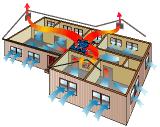Search engine visitors - click here to access entire "$ensible Home" web site
Click here to see a descriptive illustration showing several types of new whole-house fans
Dear Jim: On mild evenings, I open windows to get some fresh, cool air into my house. Would using a whole-house fan draw fresh air in quicker? Do these fans cost less to operate than my central air conditioner? - Gary W.

A: With today's airtight, energy efficient homes, it is nice to get fresh air indoors whenever possible without driving up your utility bills. Using a whole-house fan is the most effective and efficient means of bringing fresh air indoors quickly when the outdoor temperature drops.
A whole-house fan is a large fan that mounts in the attic floor. It is often located over a hallway to draw air from the entire house without creating drafts or noise in the rooms. The fan draws outdoor air in through opened windows and exhausts the air into the attic area and out the vents.
A secondary benefit of using a whole-house fan is the air flow through the attic helps to cool the attic and the roof. A hot attic and roof can radiate heat down through the attic insulation to the living areas below.
A whole-house fan uses about 80 to 90 percent less electricity than a central air conditioner. Using one can save more than $100 per year on your electric bills and reduce the maintenance needed on your air conditioner.
During hot summer weather, run the central air conditioner during the day and then use the whole-house at night. Whenever the outdoor air temperature drops to about five degrees lower than your thermostat setting, running the whole-house fan will comfortably cool your house and create a gentle breeze indoors.
There are many whole-house fan designs with various features from which to choose. For most average-sized homes, a direct-drive model with the motor in the center of the fan is a good choice. The most quiet models have vibration-blocking rubber hubs and sound-absorbing air flow shrouds.
For higher air flow capacity, a belt-drive model is often used. With this design, the motor is mounted on the corner of the frame. A belt runs from a pulley on the motor to a pulley on the fan hub. With the motor out of the air flow path and a large open diameter, the air flow can be greater.
For sizing a whole-house fan, a rule of thumb is the air flow in cubic feet per minute should be three times the house size in square feet. Some fans have two or variable speeds, so you can size it bigger for quick cooling.
For the greatest convenience, choose one with a built-in timer, thermostat or humidistat for automatic operation. Some automatically switch from high to low speed after 30 minutes. Most models offer air sealing shutters to seal off the fan when it is not running. Motorized insulated shutters are also available.
Instant Download Update Bulletin No. 641 - buyer's guide of eight whole-house fan manufacturers (28 models) listing blade diameters, maximum air flows, rpms, drive types (direct or belt drive), features, prices, suggested operation of a whole-house ventilation fan, and do-it-yourself installation instructions with a diagram, illustrations, diagram and explanation of how whole-house fan draws in cool air and expels hot air.
Dear Jim: I was trying to figure out my thermostat. When it is set to "auto," is the blower supposed to run continuously? There is also a "fan" setting, but it does not seem to do anything different. - Carl J.
A: With almost every thermostat I have seen, the "auto" setting means the blower comes on whenever the furnace or air conditioner starts. There may be a slight delay, but it should not run continuously.
The "fan" setting usually means continuous blower operation. It sounds as if you may have a bad thermostat or the blower relay is stuck closed. In either case, you will have to call a contractor to have it repaired or replaced.